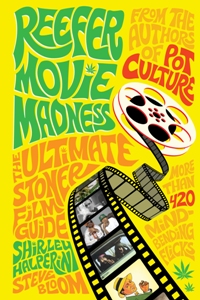Proposition 19 is getting some last-minute cash infusions from some famous folks -- not enough for a statewide TV campaign, but enough to spur get out the vote efforts. That could make a difference in this close race.
New Jersey's medical marijuana law was written as the most restrictive in the nation, and proposed state regulations released last week go even further than the spirit -- and sometimes the letter -- of the law. This fight is far from over.
Steve Bloom and Shirley Halperin discuss 700 marijuana-themed films, going back to even before the famous "Reefer Madness" movie through the present.
Another city -- and its taxpayers -- pay out the nose for SWAT team excesses.
The fate of Prop 19, California's initiative to legalize cannabis on the November 2nd ballot, will determine a lot of what happens in drug reform over the next two years. Volunteers are needed to help Prop 19 now, and you don't have to live in California.
The apparent killing of an American jet-skier on the border-straddling Lake Falcon continues to draw US media attention, but meanwhile, prohibition-related violence continues to flare across Mexico.
A massive round-up of dirty cops in Puerto Rico, a massive drug conspiracy led by a South Carolina sheriff, and another greedy jail guard make the news this week.
A new poll of three Northwest states finds a majority support pot legalization in Washington, but not yet in Oregon or Idaho. Other poll findings suggest possible problems for Measure 74 in Oregon.
Proposition 19 has picked up the support of the California chapter of one of the country's most prominent Latino organizations.
Bolivian President Evo Morales is a former coca growers' union leader, but that doesn't mean everything is swell between Evo and the cocaleros. This week is a case in point.
The opioid antagonist naloxone has long been used to prevent overdose deaths, but now it is available as a monthly injection to block cravings for heroin and prescription opiates like Oxycontin and Vicodin.
Forget "Hemp for Victory." How about "Hemp in my gas tank?" Researchers in Connecticut say it is well-suited for biodiesel.
Events and quotes of note from this week's drug policy events of years past.
The campaign to pass California's Proposition 19, the tax and regulate marijuana legalization initiative, is seeing some good-sized late donations, including contributions from Facebook co-founders Dustin Moskovitz and Sean Parker. Meanwhile, Dr. Bronner's Magic Soaps heir David Bronner has kicked in tens of thousands more for a get out the vote effort in the campaign's final weeks. And they're not the only ones making sizeable late donations.

"Yes We Cannabis" fire truck tour supporting Prop 19
Prop 19 would legalize the possession of up to an ounce of pot by adults 21 or older. It would also allow adults to grow up to 25 square feet of marijuana and possess the harvested results. It would give cities and counties the local option to allow, tax, and regulate commercial marijuana sales and cultivation.
The initiative holds a four-point lead in the
Talking Points Memo Polltracker average of the 13 polls taken on it so far this year. Prop 19 has 47.4% in the poll average to 43.2% against, with less than 10% undecided. Only three of the 13 polls have shown it losing, but with support under 50%, voter turnout and the undecideds will be critical in achieving victory.
Moskovitz has now contributed a total of $70,000 to Prop 19, while Parker has given $100,000 to a pro-Prop 19 fund controlled by the
Drug Policy Alliance (DPA). David Bronner is giving $75,000 to
Students for Sensible Drug Policy (SSDP) for a tour of college campuses designed to energize student turnout, and Washington, DC, activist and entrepreneur Adam Eidinger of
Capitol Hemp Clothing and Accessories kicked in another $25,000 for the campus tour.
Those aren’t the only big contributions to the cash-strapped campaign, which, despite having raised more than $2.1 million so far, only had $67,000 in the bank as of September 30. But according to
late filing reports, in the first few days of this month the campaign got $20,000 from Oakland cannabis entrepreneur Jeff Willcox, a $50,000 donation from Tiburon retiree Stephen Silberstein, $5,000 from Prescription Vending Machines, Inc., and $75,000 from Encino TV producer Kevin Bright. Not counting the Bronner, Eidinger, Parker, and Moskovitz donations, Prop 19 has raised $180,000 so far this month.
"More than any other initiative out there, Prop 19 will stabilize our national security and bolster our state economy," said Moskovitz in a statement explaining his support. "It will alleviate unnecessary overcrowding of nonviolent offenders in our state jails, which in turn will help California residents."
"These donations mean that these guys get it," said Stephen Gutwillig, DPA California director, referring to the Facebook cofounders. "They are members of a generation that has a consensus that the drug war is a massive failure and will never work. These donors have the means to do something about it. We're really thrilled that they're stepping up in the middle of this crucial campaign that is a bellwether in the struggle to create an exit strategy from this disastrous war on marijuana," he said. "Sean Parker and Dustin Moskovitz are pivotal to this work in this election cycle, and we hope in years to come."
DPA will use the money for get out the vote efforts, said Gutwillig. "We'll be focusing on getting young and black and Latino voters to the polls," he explained. "We don't have enough money to mount a TV ad persuasion campaign aimed at undecided voters -- that takes millions of dollars in California. But this is enough money to participate in getting reform-minded voters to the polls, reminding them that Prop 19 is on the ballot and making sure they vote between now and November 2."
If the pro-Prop 19 forces don't have the money for a TV ad campaign, they can take some solace in knowing that the opposition doesn't, either -- at least not yet. The main opposition group, Public Safety First, reported only $54,000 in the bank as of September 30. But the Prop 19 forces are waiting for -- not hoping for -- the other shoe to drop. A late, well-funded negative ad campaign in 2008 helped to defeat a sentencing reform initiative that had been leading in the polls up to that point.
"I'm calling up businesses like ours that I know are socially and environmentally conscious with a simple message, 'Just Say Now;' now is the time to step up support," said Bronner. "Prop 19 will free up police for fighting real crimes and stop renegade cannabis cultivation by gangs that are destroying our national parks. Cannabis prohibition, not the herb itself, has been ruining productive and upstanding citizens' lives with courts and jails for decades," he said.
"I was hoping to trigger more giving with our donation, and the Facebook guys helped, too," said Bronner. "This is just such an important moment; there is so much at stake. It's about being able to promote and get our message across. It's about cannabis, but it's also about freedom," he said.
"This has been pretty under-funded," said Bronner. "Richard Lee put in enough money to get on the ballot, and now it comes to getting out the youth vote. SSDP is well-positioned to drive that and already had a game plan. We're just powering that up," he said.
Late last week, Bronner and SSDP announced the "Sound the Alarm to Vote Yes on Prop 19" tour of California college campuses, complete with Dr. Bronner's promotional fire truck, now known as the "Yes We Cannabis Fire Truck." The tour kicked off in San Diego last weekend, and will crisscross the state in the three weeks until Election Day -- this weekend it will be in the Bay Area for SSDP's regional conference in San Francisco.
"Young voters are the primary victims of the drug war and logically the largest group of supporters of Prop 19," said SSDP executive director Aaron Houston. "We plan to register thousands of students in the next 10 days and help many first time voters develop plans for Election Day. Meshing good old fashioned one-on-one on college campuses with mobile alert technology sums up our strategy to turn out young voters," he added.
SSDP had already planned a get out the vote effort in conjunction with Firedoglake's
Just Say Now campaign, but will now expand that effort thanks to the Bronner and Eidinger donations. "We are ramping up our outreach to even more students thanks to the surprise support," Houston said.
It's just three weeks from Election Day. The race is tight. The final push is on, the energy level is high, and late donations can help make the difference.
back to top
The New Jersey Department of Health and Senior Services released highly restrictive regulations for the state's medical marijuana program last week, tightening the screws on what patients, lawmakers, and advocates were already calling the most restrictive medical marijuana program in the country. Medical marijuana supporters were quick to react.

Sen. Scutari and Mike Oliveri after January's vote
The proposed regulations limit access to patients suffering from at least one of nine specified diseases or conditions and require that their recommending physicians have been treating them for at least a year and have had seen them in their offices at least four times. Recommending physicians must be prepared to state that other therapies have been tried and failed.
Patients must then be approved by a state-appointed review panel. If approved, they can obtain medicine only from one of four dispensaries or have it delivered to them by a dispensary (unless they are within 1,000 feet of a school). Patients cannot grow their own, nor can they designate a caregiver to grow for them, although they can designate a caregiver to pick up their medicine if necessary. They are limited to two ounces per month.
The regulations specify that medical marijuana can be no stronger than 10% THC and that only three strains will be available. The medicine can be formulated as dried flowers, oral lozenges, or a spray.
Nonprofit dispensaries, or Alternative Treatment Centers, would obtain their supplies from one of two grow operations licensed by the state. Application fees for dispensaries are $20,000, with only $18,000 refundable if the application is denied. There is also a $20,000 annual renewal fee.
Limiting dispensaries to four directly contradicts New Jersey's
medical marijuana law, passed earlier this year, which specifies a minimum of six.
Dispensaries would not be allowed to serve food or beverages or provide for on-site consumption, nor would they be allowed to sell marijuana-themed apparel or other paraphernalia to the public, though they would be able to sell such products to patients. And they must adhere to a written drug-free workplace policy.
Dispensaries delivering medical marijuana to patients must have two employees in the delivery vehicle. The vehicles must have separate lock boxes, one for the medicine and one for the cash. And delivery vehicles cannot bear advertising. But wait, there's more: Dispensaries must have a $1,000,000 insurance policy on each vehicle, delivery cannot be made the same day the patient places an order, and dispensaries must tell patients not to engage in "extraneous conversation" with the delivery persons.

Don McGrath, at 2004 CMMNJ event dedicated to his late son Sean
The regulations also push back the start-up date for the program to July 2011. That's a year and a half after then Gov. Jon Corzine (D) signed legislation into law. Sitting Gov. Chris Christie (R) had asked for a six to nine month delay in implementing the law earlier this year. The legislature gave him three months.
"We have designed a clinically sound program that is unique to New Jersey,’’ said Health Commissioner Poonam Alaigh. "It is a physician-driven program that provides access to qualified patients for whom conventional treatment has failed and who may benefit from medicinal marijuana as a symptom reliever. The program is also designed to ensure that patients receive ongoing medical care from a physician."
If Alaigh was happy with the regulations, the authors of the law were not. "I don't want them rewriting my law," Sen. Nick Scutari (D-Union) told the
Newark Star-Ledger the same day the regulations came out. He cited the proposal to reduce the number of dispensaries from six to four. He added that he was also disappointed in the proposed July 2011 start up date. "That's not right either."
"If we don’t follow the spirit of the law to a 'T' we will essentially be erasing the compassionate element in this act," said Assemblyman Reed Gusciora (D-Mercer), one of the law's primary proponents, in a
press release the next day. "My foremost concerns are that the department is moving towards allowing only four alternative treatment centers and two cultivation centers while also limiting the allowable THC levels and the forms in which patients can use medical marijuana. Not only does this violate the legislative intent of the bill but it also means that we will be limiting the availability of this treatment alternative to only a select few."
"It seems that the goal of the regulations is to provide the least amount of relief to the least number of patients," said Roseanne Scotti, Director of the
Drug Policy Alliance New Jersey office, which spearheaded the effort to pass the legislation. "The major problems with the proposed regulations are that they only allow for four locations where patients can access medical marijuana and they place unnecessary restrictions on those locations. Imagine if there were only four pharmacies in the whole state where seriously ill patients could get their medications."
"These proposed regulations go far beyond the already strict limits spelled out in the legislation," said Don McGrath, whose son Sean who died from a rare form of cancer several years ago and used medical marijuana to relieve the symptoms of his disease. "We already had the strictest law in the country. I don’t see how the program will be workable with these restrictions." McGrath, who advocated for the legislation for years and testified before the New Jersey Legislature on several occasions, also questioned whether the regulations violated the law and the intent of the legislators who voted for it. "The legislature clearly intended for there to be
at least six locations where medical marijuana would be dispensed. That is the exact language in the bill. But the Department of Health and Senior Services has decided to reduce that number below the minimum required. How is that legal?"
"This is appalling and will hurt patients in a big way," said Michael Oliveri, who has muscular dystrophy and uses medical marijuana to treat his symptoms. "There are many stains of medical marijuana and they have different properties. There are different health benefits for each strain. Some are good for sleep, some for pain, some for appetite stimulation. Patients need to be able to access and try the type that works best for their symptoms." Oliveri, whose family lives in Oradell, moved to California several years ago so that he could legally access medical marijuana. He returned to New Jersey several times during the fight for the legislation to advocate for New Jersey to pass a medical marijuana bill.
"Rather than create a reasonable set of regulations, the Christie Administration is playing politics with the lives of New Jersey's most severely ill residents. Instead of opening a pathway to safe marijuana access these draft regulations only create more barriers," said Chris Goldstein, a spokesman for the
Coalition for Medical Marijuana-New Jersey. "Patients in New Jersey now have a legal right to medical marijuana. These draft regulations are deeply flawed and do not reflect the vision that patients, advocates and the legislation have for compassionate access."
Goldstein raised suspicions that some sort of corporate-friendly fix was in. "These regulations were written for somebody. They feel that somebody can actually fulfill this the way it was written," he said.
He also questioned the department's due diligence in researching medical marijuana and programs in other states. "That they did all this research over months and months, and then came back with these regs tells me it's about politics, not about science and research," he said. "No medical marijuana expert will tell you that capping THC is a great idea or that three strains is adequate for the patient population of a whole state."
Goldstein said CMMNJ is weighing its options and will be holding a board meeting Thursday evening to plot out a course of action. "We haven't had a chance to formulate a strategy for moving forward yet, but you can rest assured we will have a loud and vocal presence."
Years of lobbying and campaigning by patients and advocates were rewarded in January, when the law was signed. Little did they know the nature of the obstacles they would face in actually getting a working law. Now they do, and the fight is on.
back to top
Reefer Movie Madness: The Ultimate Stoner Film Guide, by Steven Bloom and Shirley Halperin (2010, Abrams Image Press, 336 pp., $18.95 PB)
Even the wonkiest of drug policy reformers can't spend all their time reading policy proposals, research results, and desert-dry academic treatises, but
Reefer Movie Madness is much more than a mere guilty pleasure. Penned by former High Times editor and
Celebstoner.com proprietor Steve Bloom and former High Times intern turned entertainment writer Shirley Halperin,
Reefer Movie Madness is not only a most excellent guide to stoner filmdom, it also maps the cultural acceptance of marijuana in America through film history.
A follow-up to the pair's well-done, comprehensive compendium of all things cannabinical,
Pot Culture,
Reefer Movie Madness profiles more than 700 films that are about marijuana, feature marijuana in key scenes, feature other drugs, or just plain a gas to watch stoned. The films are ranked via a five-star rating system, and the authors demonstrate exquisite taste and filmic knowledge in their rankings (meaning that their tastes agreed with mine).
They begin at the beginning, going back even before 1936's anti-pot propaganda classic
Reefer Madness to note such obscure films as 1924's
High on the Range, in which Cowboy Dave smokes a reefer, and 1933's
International House, in which jazz legend Cab Calloway performs "Reefer Man."
But in the late 1930s, as Harry Anslinger crusaded against the demon weed, so did Hollywood. In addition to
Reefer Madness, the movie industry cranked out propaganda like
Marijuana: The Weed with Roots in Hell (1936), Assassin of Youth (1937), and just a handful of years later,
Devil's Harvest (1942). While such films helped shape American attitudes at the time, and for decades to come, they are now the stuff of nonstop laugh fests.
While marijuana and other drug use was portrayed intermittently, and occasionally, even with some sympathy for drug users, it wasn't until the cultural revolution of the 1960s, bringing us classic stoner films like
Wild in the Streets (1968) and
Easy Rider (1969), that pot-smoking began to be widely portrayed as anything but deviant. And it wasn't until the late 1970s that Cheech and Chong's
Up in Smoke gave birth to the now ubiquitous stoner comedy genre (although Bloom and Halperin give the classic
Animal House, with its single hilarious pot-smoking scene partial credit for establishing the genre, too).
By now, stoner movies and depictions of pot-smoking are everywhere, most notably, but not only, in the stoner comedy genre. Films like
Half-Baked,
How High,
Friday, and
Strange Wilderness are now being produced by mainstream production companies, and the Judd Apatow franchise alone has been responsible for numerous box office hit stoner flicks, including
The 40-Year-Old Virgin, the underrated
Walk Hard: The Dewey Cox Story,
Knocked Up,
Forgetting Sarah Marshall,
Superbad, and
Pineapple Express. This year's
Get Him to Greek, featuring the inimitable and charismatic Russell Brand and Apatow regular Jonah Hill, was released too late for inclusion, but will certainly make the next edition.
The book is divided into sections by genre: comedy, drama, sci-fi/fantasy/horror, action, sports, music, documentaries and offers spot-on capsule reviews of more than 700 films, complete with plot summaries, star rankings, and choice quotes. Reefer Movie Madness also includes themed lists (Best Buds: Ten stony duos that take friendship to a higher level; Stoner Inventions and Innovations), celebrity Q&As, and lists of favorite stoner movies from well-known actors, directors, and musicians, including Cheech & Chong, the Trailer Park Boys, Snoop Dog, and Melissa Etheridge, among many more.
Reefer Movie Madness is a bookshelf must for pot movie fans, whether they be culture mavens or fully-baked couch potatoes. Even for veteran stoner film watchers, it contains some delicious movies you've never seen before and helps you remember long-forgotten gems. It has already vastly increased the length of my Netflix queue, and once you pick it up, the same thing is going to happen to you.
But beyond that,
Reefer Movie Madness is a valuable and important contribution to charting and understanding the pop cultural role of marijuana in the past few decades. And it's a gas to read, stoned or not.
back to top
The city of Oakland will pay out $1.2 million to settle a lawsuit filed by a woman who suffered serious burns from a flash-bang grenade thrown by a SWAT team officer during a 2008 drug raid. The city council voted to approve the settlement in closed session October 5 without admitting any wrongdoing.

SWAT raid
Nicole White, 31, was visiting a home in East Oakland and sleeping on a couch in the living room when an Oakland Police SWAT team serving a drug search warrant broke through the door after home resident Patricia Wilson slammed it in their face. One team member, Officer Chris Saunders, threw a flash-bang grenade toward a hallway, but it ricocheted into the living room, burning White on her chest and leg. Wilson was also injured, and has received a $45,000 pay-out from the city.
White suffered burns on 11% of her body and was permanently disfigured. She spent nearly a month being treated in the hospital. Her medical expenses ran to $400,000.
"This was a real tragedy," White's attorney, John Burris, told the
San Francisco Chronicle. "The conduct of the police was reprehensible."
White's lawsuit accused police of using an "extreme level of force" in throwing the grenade in the house. Police should have known that flash bangs, which emit a loud noise and blinding flash upon detonation, could burn or injure innocent bystanders, the lawsuit said.
The lawsuit also accused police of conducting the raid to retaliate against a man connected to the home who had just three days earlier filed a class-action lawsuit accusing officers of lying on search warrants. The city denied any link, saying police believed people at the residence were armed gang members. Police found two shotguns in a garage, as well as unspecified quantities of heroin and cocaine. Neither White nor Wilson were charged.
The man who filed the class action suit, Roland Oliver, had been arrested at the house in March 2008. But prosecutors dismissed the case after finding that Officer Karla rush falsely stated on a search warrant affidavit that suspected drugs seized during his arrest had been tested and confirmed as actual drugs. That case was one of a series of similar cases in which officers lied about having confirmed drug samples. Four officers, including Rush, were fired, although one got his job back through arbitration.
back to top
Dear drug policy reformer,
You may have read about me
this week on StoptheDrugWar.org. My family and over 60 employees in California produce the best-selling natural brand of soap in the United States. Last week I made a personal $75,000 donation for a statewide
"Yes We Cannabis" student fire truck tour of campuses throughout California, registering voters and getting people to the polls to
pass Prop 19 and legalize cannabis this Election Day. You can read about why I decided to do this
here.
I'm writing because StoptheDrugWar.org and the Prop 19 campaign need your help. Polls show Prop 19 in the lead, but it's close, and voter turnout in this midterm election year could make or break it. There are important initiatives in Arizona, South Dakota and Oregon too. Whether you live in one of these states or not, there are thins that you can help with:
- Register to Vote: Click here to print a form out that you or your friends can submit to your local election office. You have to register by the 18th to vote in California this year.
- Phone Bank: Call people in California to get them out to the polls: Sign up to phone bank using email or Facebook or Twitter. Join the StoptheDrugWar.org Group on the site. Watch the Prop 19 phone bank training video. Go to the dashboard (between noon and 11:59 EST) and choose California or one of the other initiative states. (Make sure you've watched the video.) Then start calling voters. (Don't forget to invite more people to join the effort too.)
I'm grateful to Richard Lee for putting Prop 19 on the ballot with $1.5 million of his own money, and I'm proud that I could do this for Prop 19 too. Now it's your turn: The time StoptheDrugWar.org members spend at home or a friend's home or a coffee shop with your cell phone, could literally be what makes legalization happen this year. So please sign up and volunteer today!
Sincerely,
David Bronner, President
Dr. Bronner's Magic Soaps
P.S. Voter registration in California ends on Monday, a few days from now. So please don't wait -- please volunteer today!
back to top
by Bernd Debusmann, Jr.
Mexican drug trafficking organizations make billions each year smuggling drugs into the United States, profiting enormously from the prohibitionist drug policies of the US government. Since Mexican president Felipe Calderon took office in December 2006 and called the armed forces into the fight against the so-called cartels, prohibition-related violence has killed more than 28,000 people, the government reported in August. The increasing militarization of the drug war and the arrest of dozens of high-profile drug traffickers have failed to stem the flow of drugs -- or the violence -- whatsoever. The Merida initiative, which provides $1.4 billion over three years for the US to assist the Mexican government with training, equipment and intelligence, has so far failed to make a difference. Here are a few of the latest developments in Mexico's drug war.

Culiacan Cathedral, Sinaloa
In Tijuana,
President Calderon said that California's ballot measure to legalize marijuana represents hypocrisy in US drug policy. "For me, it reflects a terrible inconsistency in government policies in the United States," he said, referring to US demands that Mexico and other countries clamp down on production and trafficking.
Saturday, October 9
In Oaxaca,
the mayor-elect of a small town was shot and killed . Antonio Jimenez Banos, 47, was due to become the mayor of the small coastal town of Martires de Tacubaya. He was shot in the head and chest as he returned home to his small farm. Eleven sitting mayors have been assassinated in Mexico this year, as well as several candidates and representative-elects.
In Ciudad Juarez,
12 people were killed in several incidents. In one incident, two prisoners inside the city’s main prison were killed during a prison riot between the rival Azteca and Mexicles gangs, which work for the Juarez and Sinaloa cartels, respectively. At the same time, another riot occurred in a municipal prison. Soldiers responding to the incident confiscated an unknown quantity of weapons and drugs.
Sunday, October 10
In Ciudad Juarez,
six people were killed. In one incident, a group of armed men shot dead three people outside an emergency room hospital. The three men were apparently attempting to flee and hide from the gunmen, but were gunned down just outside the building.
Monday, October 11
In Sinaloa,
eight police officers were killed after their convoy was ambushed by gunmen. The officers were patrolling a highway about 50 miles outside of the state capital of Culiacan when they were attacked by a convoy of gunmen traveling in three or four vehicles and wielding automatic weapons. Mexican news sources have reported that three other officers were wounded in the attack. Sinaloa has long been at the heart of Mexico's drug trade. Marijuana and poppy is grown in the area and large-scale meth labs have been known to operate in the area.
In Ciudad Juarez,
14 people were killed across the city. The murders occurred despite immensely tight security in the city due to the arrival of President Calderon and a security summit with Mexican governors.
Tuesday, October 12
According to a Zapata County Sheriff,
a Mexican investigator working on the recent Falcoln Lake shooting incident was beheaded. Rolando Flores was a member of the State police based in the city of Miguel Aleman, and was part of the team investigating the shooting of David Hartley, who has been missing since September 30
th. Flores' head was reportedly found in a suitcase left outside a Mexican Army installation.
Total Body Count for the Week: 85
Total Body Count for the Year: 8,390
Read the previous Mexico Drug War Update here.back to top
A massive round-up of dirty cops in Puerto Rico, a massive drug conspiracy led by a South Carolina sheriff, and another greedy jail guard make the news this week. Let's get to it:
In Columbia, South Carolina, the
former Lee County sheriff pleaded not guilty last Thursday to 47 new charges in what prosecutors are calling a complex drug conspiracy case. Former Sheriff EJ Melvin resigned in May after he and 11 others were charged with a drug distribution conspiracy. In an earlier indictment, witnesses accused Lee of dealing cocaine from his official vehicle and state police agents said that they had given Melvin a list of possible drug dealers, only to have him use it to tip off the dealers and plan to get money from other dealers in exchange for keeping agents away. The second indictment charges that Melvin abused his position as sheriff to enrich himself and others through drug dealing, extorted kickbacks, and money laundering. He is now facing one count of conspiracy to distribute more than five kilograms of power cocaine, 20 counts of extorting kickbacks from drug dealers, three counts of money laundering, one count of taking more than $5,000 in victim assistance funds for personal use, three counts of lying to state and federal agents, and 18 counts of using a telephone to facilitate drug trafficking. He faces up to life in prison for the drug conspiracy and between 20 and life for the racketeering counts. Amazingly, he has been allowed to remain free on bail.
In Puerto Rico,
133 police officers, prison guards, and US Army officers were arrested last Thursday in a series of FBI raids aimed at law enforcement officials helping drug traffickers. Some 750 agents were involved in the massive operation, which covered the entirety of the US territory. Those rounded up face charges conspiracy to possess with intent to distribute more than five kilograms of cocaine and illegal firearms offences. Prosecutors allege the police officers provided security for drug dealers at up to $4,500 a pop. If convicted, the defendants face from 10 years to life in prison.
In Chicago,
a Cook County jail guard was arrested October 4 after being caught on camera accepting marijuana and cocaine to be delivered to an inmate. Guard Timothy Fuller, 42, is charged with possession of marijuana, possession of cocaine, possession of marijuana with intent to deliver and possession of cocaine with intent to deliver after being caught by a sting investigation. Fuller went down after jail officials got suspicious and set up a sting. Fuller met with a woman who supplied him with 16 grams of cocaine and 135 grams of pot and paid him $400 to smuggle the contraband into the jail. But the woman was an undercover cop, the camera was rolling, and now Fuller is looking out from the wrong side of the bars.
back to top
A majority of Washington state residents favor legalizing marijuana, but support levels are not as high in Oregon and Idaho, according to a new tri-state poll. Some 55% of respondents in Washington supported legalization, with 34% opposed, while in Oregon, it won a narrow plurality (45% to 43%), and in Idaho, opposition was at 52%, with only 37% in favor.

Mt. Hood, northern Oregon
The poll results are from a survey of the three Northwest states' residents conducted by the polling firm
Davis, Hibbitts, and Midghall (DHM) for the Northwest Health Foundation and public radio stations across the region. The poll results have not yet been posted, but DHM's Adam Davis shared preliminary results with Drug War Chronicle during a phone interview Monday.
Davis said full results would be posted at DHM "in a day or two."
The survey asked four generic marijuana-related questions: Has your attitude toward marijuana changed over time (and if so, in what direction); do you support state laws permitting medical marijuana; are you comfortable with a medical marijuana dispensary in your neighborhood; and do you support the legalization of the purchase and possession of marijuana?
While majorities in all three states said their attitudes toward marijuana had remained the same over time, those who said their attitudes had changed broke two-to-one toward more tolerant attitudes.
Davis said support for medical marijuana was at 64% in Oregon, with 30% opposed. Compared to Oregon, "Washington was more supportive and Idaho less so," said the pollster. "There is pretty strong support, generally speaking. It leads almost two-to one."
But having a medical marijuana dispensary in the neighborhood didn’t fare nearly as well. Only in Washington were a majority (52%) comfortable with a local dispensary, with that figure dropping to 43% in Idaho and, surprisingly, only 40% in Oregon.
That last figure could have immediate real world ramifications. Oregon voters will decide next month on
Measure 74, which would allow for a regulated dispensary system. This poll finding, while isolated, suggests that voters could turn away from the initiative next month. Get to the polls, Oregon medical marijuana supporters!
back to top
The League of United Latin American Citizens (LULAC) of California has endorsed Proposition 19, California's tax and regulate marijuana legalization initiative. LULAC is one of the most prominent organizations representing Latino voters. The group announced Friday it is supporting the initiative.
"The current prohibition laws are not working for Latinos, nor for society as a whole," said Argentina Dávila-Luévano, California LULAC State Director. "Far too many of our brothers and sisters are getting caught in the cross-fire of gang wars here in California and the cartel wars south of our border. It's time to end prohibition, put violent, organized criminals out of business and bring marijuana under the control of the law."
Proposition 19 would legalize the possession of up to an ounce of marijuana by adults over 21 and allow them to grow their own in a space of up to 25 square feet and possess the harvest. It would also allow counties and municipalities to permit, regulate, and tax commercial marijuana sales and cultivation.
In a June report, the Drug Policy Alliance found that while blacks and Latinos made up 44% of the state's population, they accounted for 56% of pot possession arrests. The report concentrated on African-Americans because the FBI's Uniform Crime Report data on which it was based does not recognize Latino as a racial category, instead lumping Latinos in with whites. Still the language of the report applies to Latinos as well.
Calling racially disproportionate marijuana arrests "a system-wide phenomenon," the report explained why: "Police departments deploy most patrol and narcotics police to certain neighborhoods, usually designated 'high crime,'" the authors wrote. "These are disproportionately low-income, and disproportionately African-American and Latino neighborhoods. It is in these neighborhoods where the police make most patrols, and where they stop and search the most vehicles and individuals, looking for 'contraband' of any type in order to make an arrest. The item that young people in any neighborhood are most likely to possess, which can get them arrested, is a small amount of marijuana. In short, the arrests are racially-biased mainly because the police are systematically 'fishing' for arrests in only some neighborhoods, and methodically searching only some 'fish.' This produces what has been termed "racism without racists.'"
It's not just the arrests, said LULAC board member Angel Luévano. "In these tough economic times we must find ways to provide new jobs for our people and prosperity in our communities. Supporting Prop 19 will put more Latinos to work and generate cash for our state's budget," she said. "It's our neighborhoods and our families that suffer the most from widespread and ever-increasing unemployment and budget cutbacks for schools and public safety programs."
LULAC of California is just the latest in an ever-growing list of Prop 19 endorsers, including the National Black Police Association, the NAACP of California, and the Latino Voters League. To see them all, click here.
back to top

Presidential Palace, La Paz (Phil Smith for Drug War Chronicle, 2007)
Faced with protests and road blockades from angry coca growers, the Bolivian government said Monday it was
annulling a new coca production law that would reduce by two-thirds the amount of coca leaves producers could sell. But even that move may not be enough to end the dispute between the government of President Evo Morales, himself a former coca grower union leader, and the main Yungas growers' association.
The government last month approved the new law, which limited coca growers to selling five pounds of leaf a month, down from the current 15. The now-repealed law would also have given the central government control over sales, which are currently controlled by local communities. The government said it passed the bill in a bid to reduce the sale of coca leaf to cocaine traffickers.
Minister of Government Sacha Llorenti Solid told a Monday press conference that the law would be repealed because the government had failed to consult with all coca growers. "Because of this, and recognizing this mistake, we have gone back and annulled the law, and make clear that any changes will be made in consultation, by consensus and in coordination with social organizations," he said.

coca leaves drying by highway, Chapare region (Phil Smith for Drug War Chronicle, 2007)
Llorenti also called on growers to stop blocking roads in the Yungas coca-producing region, saying there was no reason to continue the protests. But Ramiro Sanchez, head of ADEPCOCA (the Coca Growers' Association of the Department of Yungas), said not so fast.
"These are not guarantees for us and are not enough to lift the road blocks," he said. "That's why they need to come down here. We can't engage in dialogue up there" in La Paz.
Sanchez said protestors, which he numbered at some 4,000, would stay despite the repeal of the coca law because coca growers still had issues they wanted the government to address. He cited improvements in roads and the construction of a coca industrialization plant.
While Morales has long been sympathetic to coca growers and their needs, and while coca growers have traditionally supported his Movement to Socialism (MAS) party, tensions have flared this year. In May, two people were killed after police were sent in to clear another roadblock.
Bolivia is the world's third largest coca producer, behind Peru and Colombia.
back to top
The US Food and Drug Administration (FDA) announced Tuesday that it had approved a once-a-month injectable drug for use in treating opiate addiction. The drug, marketed as Vivitrol, is a form of naloxone, an opioid atagonist that blocks the action of opioids on brain cells and is currently used in responding to overdoses.
In approving Vivitrol, the FDA cited a Russian study with 250 heroin addicts that found it reduces relapse rates and blocks cravings for narcotics. In that study, after six months, 86% of subjects taking Vivitrol had stayed off opiates and were functioning in work or school, compared to only 57% who were given a placebo.
Unlike methadone and buprenorphine, which are commonly used in opiate substitution treatments, Vivitrol is not addictive and does not maintain opiate dependency. Additionally, unlike those two substitutes, Vivitrol does not need to be taken daily, but is instead administered monthly via intramuscular injection.
The approval of Vivitrol for opiate addiction is "an important turning point in our approach to treatment," said Dr. Nora Volkow, head of the National Institute on Drug Abuse, in a statement greeting the FDA announcement.
Nearly 810,000 Americans are addicted to heroin, with more than twice that number using prescription opioids, such as Oxycontin and Vicodin, for non-prescription purposes, Volkow noted.
back to top
Researchers at the University of Connecticut reported last week that the fiber crop cannabis sativa, also known as industrial hemp, has several qualities that make it an attractive feedstock for producing biodiesel, a sustainable diesel fuel made from renewable plant resources.

car powered by hemp-based biodiesel fuel (hempcar.org)
Industrial hemp can grow in infertile soils and does not require lots of water, fertilizer, or high-grade inputs to flourish, said researchers led by Dr. Richard Parnas, a professor of chemical, materials, and biomolecular engineering. It produces strong fibers that, until the advent of synthetic fibers in the 1950s, made it the premier product used in making rope and clothing around the world.
Currently, much biodiesel feedstock comes from crops that could otherwise be used for human food consumption, such as soybeans, peanuts, olives, and rapeseed. Similar problems face the production of ethanol, which diverts corn that could have been used for cattle feed (and ultimately consumed as meat by humans) into the fuel production market.
"For sustainable fuels, often it comes down to a question of food versus fuel," said Parnas. "It's equally important to make fuel from plants that are not food, but also won't need the high-quality land."
Parnas pointed out that much of the world still relies on hemp as a primary fiber, mainly because of its ability to "grow like a weed." But in fiber production, hemp seeds are often discarded, and, the researcher said, this waste product could be put to good use by using it as a fuel.
"If someone is already growing hemp," he said, "they might be able to produce enough fuel to power their whole farm with the oil from the seeds they produce."
Parnas and his team used virgin hemp seed oil to create biodiesel using a process called transesterification and achieved a high conversion efficiency with 97% of the hemp oil being converted to biodiesel. The university holds a patent on a biodiesel reactor system that could be customized to make biodiesel from a range of feedstocks, including hemp.
"Our research data could make buying a reactor system with our technology more attractive," says Parnas. "If we have data for the production of many different feedstocks, we can tailor the system to meet the company's needs."
Industrial hemp is grown in Canada, China, and European countries, among other places. But the DEA has barred its production in the US, leading to a bizarre situation in which American farmers have to sit idly by while industrial hemp products are imported from other countries. A number of states have passed legislation authorizing hemp research or production, but they are blocked by the DEA, which refuses to recognize any difference between high-fiber, low-THC hemp and low-fiber, high-THC marijuana.
back to top
October 14, 1970: President Nixon spearheads the Controlled Substances Act (CSA), legislation establishing today's "schedules" as a means of classifying drugs strictly by their medical value and potential for abuse. In practice the science drug scheduling has often yielded to drug war politics, however.
October 15, 1986: Assistant Attorney General Mark Richard testifies before the Kerry Committee that he had attended a meeting with 20 to 25 officials and that the DEA did not want to provide any of the information the committee had requested on the involvement of US-backed Nicaraguan Contra rebels in drug trafficking.
October 19, 1999: Taking a states' rights approach to medical marijuana, candidate George W. Bush says, "I believe each state can choose that decision as they so choose." As president, Bush instead escalates prosecutions of medical marijuana providers by the US Dept. of Justice and opposes states' rights arguments in court proceedings.
October 17, 2002: Florida Governor Jeb Bush's daughter is sentenced to 10 days in jail and led away in handcuffs after being accused of having crack cocaine in her shoe while in drug rehab. In a statement, the governor says he realizes his daughter must face the consequences of her actions.
October 14, 2003: Supreme Court justices reject the Clinton administration's request, continued by the Bush administration, to consider whether the federal government can punish doctors for recommending or even discussing the use of marijuana for their patients. The decision by the High Court clears the way for state laws allowing ill patients to smoke marijuana if a doctor recommends it.
October 14, 2003: At Emory University Law School former President Jimmy Carter says, "All three of my boys smoked pot. I knew it. But I also knew if one was caught he would never go to prison. But if any of my [black] neighbors got caught, they would go to prison for ten, twelve years. No law school has had the temerity to look at what is fundamentally wrong with our legal system, which discriminates against the poor."
October 20, 2004: A groundbreaking coalition of black professional organizations comes together to form the National African American Drug Policy Coalition (NAADPC). NAADPC "urgently seeks alternatives to misguided drug policies that have led to mass incarceration."
back to top











